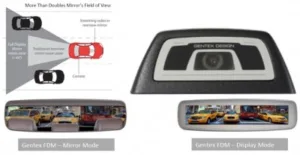The technology used in automobile rear view mirrors has followed a logical progression. First, it was a simple mirror, then a day/night option was added. Next, the mirror became auto dimming and other non-mirror related features were added to the device. Now, Gentex Corp. (Zeeland, MI) has developed a next generation product. The rear view mirror can now be switched from a mirror to an LCD that presents a wide angle view of traffic behind your car.
Gentex first announced the “streaming video mirror” as a concept about one year ago. It is now a product that the company calls a “Full Display Mirror.” The first deployment of the product will be in the Cadillac XT5 where the option will be called a “Rear Camera Mirror.”
The Full Display Mirror presents an image captured by a camera mounted above the car’s rear license plate. The image is presented on a 1280 x 240 pixel LCD display (171 pixels per inch) embedded in the rear view mirror. The driver switches between views using what, in a traditional rear view mirror, would be the day/night lever.
The field of view presented on the LCD mirror is about four times as wide as a traditional mirror. Because the camera is outside the car, the view is not obstructed by back seat headrests, passengers or restricted by the size of the rear window.
In its reflective mode, a conventional electrochromic shutter automatically dims the view when bright headlamps shine on the mirror. In addition, the system includes a high dynamic range camera that reduces glare at night. In this approach, each pixel sets its own exposure. The result is that headlights appear as bright objects but darker objects are also visible.
There are some differences between a conventional mirror and the Gentex mirror that require getting-used-to by the driver. First, the view is 8-10 feet (2.5 – 3m) farther back than that presented by a traditional mirror. Second, the camera is mounted lower than the rear view mirror. Users report that these differences are not all that noticeable when driving on the highway. They are, however, noticeable when driving in the city or in heavy traffic.
A more subtle difference is the fact that drivers needs to focus on an LCD that is 18-24 inches (45-60 cm) away from their eyes as opposed to focusing at infinity as is the case with a conventional mirror.
There is a potential for road conditions to degrade the image produced by the camera. Rain and/or splatter from the highway come to mind. To partially address this issue, the lens has a hydrophobic coating.
Gentex currently has 10 patents on the mirror system. Included in this portfolio is IP for the overall streaming video mirror concept, calibration for the wide angle view image, image de-warping, glare reduction and the design of the camera’s hardware.
In addition to rear view mirrors, automakers are also investigating the use of display/camera systems as a replacement for side mirrors. One advantage of such an approach is a reduction in wind resistance. Another is that the car is made narrower making it easier to fit into width limited spaces. At this time there is ongoing research into means of stitching together images from multiple outside cameras to give an even more complete view of the environment surrounding the vehicle. -Arthur Berman

